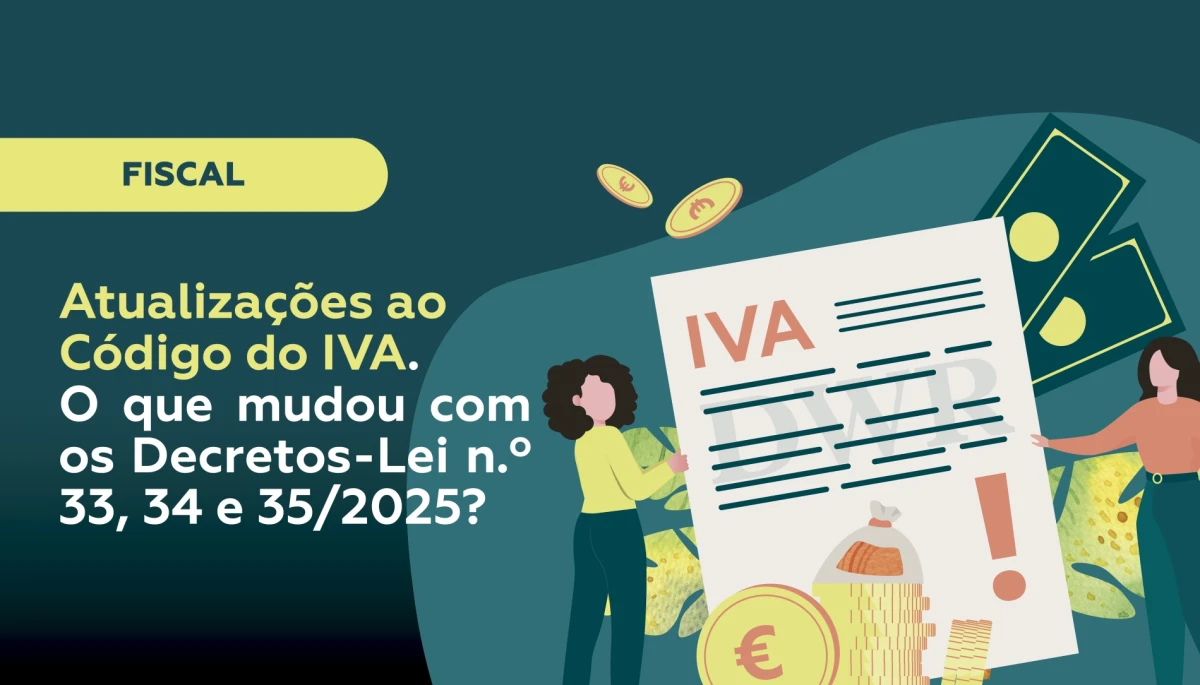
Fiscal analysis of the proposed State Budget for 2025

The Government delivered the State Budget proposal for 2025 to the Assembly of the Republic, which will now be discussed in the specialty.
Despite the changes that the parliamentary discussion may introduce, the major options in fiscal matters are already known.
We share the analysis of Dower's Tax Law Department, with a special focus on what will change and the impact it will have on the lives of companies and families.
- Personal Income Tax (IRS)
General Rates
The limits for each bracket of the general IRS rates are updated by approximately 4.6%, resulting in the following table:
|
Taxable Income (€) |
Tax (%) |
Amount to Deduct (€) |
|
From 8 059 |
13,00 |
0,00 |
|
More than 8 059 to 12 160 |
16,50 |
282,07 |
|
More than 12 160 to 17 233 |
22,00 |
950,91 |
|
More than 17 233 to 22 306 |
25,00 |
1 467,91 |
|
More than 22 306 to 28 400 |
32,00 |
3 029,38 |
|
More than 28 400 to 41 629 |
35,50 |
4 023,14 |
|
More than 41 629 to 44 987 |
43,50 |
7 353,76 |
|
More than 44 987 to 83 696 |
45,00 |
8 028,38 |
|
More than 83 696 |
48,00 |
10 539 |
Youth IRS
Expansion of the current regime, applicable to young individuals (not dependents) up to 35 years old, regardless of their level of education, and applied to income from Categories A and B.
The duration is extended to 10 years (previously 5 years), starting from the option exercised by the taxpayer in their tax return, and continuing for the following nine years, up to the age limit.
An increase in the applicable exemption is also expected, as follows:
- 100% in the first year;
- 75% in the second, third, and fourth years;
- 50% in the fifth, sixth, and seventh years;
- 25% in the eighth, ninth, and tenth years.
The exempt income is limited to an amount corresponding to 55 times the value of the IAS (currently 28 009,30€, based on the current IAS).
The taxpayer may request the income-paying entity to adjust the withholding tax in accordance with this regime, informing them of the current year of income under this scheme.
The exemption does not apply in years when no income from Categories A and B is earned. However, the exemption will resume for the remaining eligible years once such income is earned again, up to a total of ten years of exemption (until the age of 35).
Regarding the transitional regime, taxpayers who qualify for this exemption in the year following the number of years in which income (Categories A and B) was earned will not include the years in which they were dependents.
Excluded from this regime are:
- Those who benefit or have benefited from the non-habitual resident regime;
- Those who benefit or have benefited from the tax incentive regime for scientific research and innovation (Article 58-A of the Tax Benefits Statute);
- The ex-residents regime;
- Those who do not have their tax situation regularized.
Specific Deduction
The specific deduction for Categories A and H is updated to an amount corresponding to 8.54 x IAS, which is 4 349,08€.
Meal Allowance
It is proposed to increase the amount of the non-taxable meal allowance, provided through meal vouchers, to a daily value of 10,20€, meaning that only the portion exceeding 70% of the established legal limit (currently 6€) will be considered taxable employment income, instead of the previous 60%.
Autonomous Taxation Rates
An update is proposed to increase the limit for the acquisition costs of light passenger or mixed vehicles from 20 000€ to 30 000€ for the purposes of applying autonomous taxation on expenses incurred by taxpayers who are required to maintain organized accounting in the context of carrying out a business or professional activity.
Withholding Tax for Self-Employed Workers
A reduction of the withholding tax rate on IRS applicable to income from professional activities, as specified in the table referred to in Article 151 of the IRS Code, is proposed, decreasing from 25% to 23%.
Payments on Account
It is proposed to reduce the amount of payments on account due from holders of Category B income, changing it to 65% of the value derived from the application of the current formula (currently, 76.5%).
Withholding Tax on Overtime Work
The exemption from the withholding tax on income from overtime work earned in Portugal by non-resident taxpayers will now apply to overtime income up to 100 hours (currently 50 hours).
It is also proposed that remuneration for overtime work earned by resident taxpayers will be subject to 50% of the autonomous withholding tax rate from the first hour of overtime worked (currently, this applies starting from the 101st hour).
- IRC
Rates
The standard rate is reduced by 1%, decreasing from 21% to 20%. The reduced rate for SMEs and small and medium-sized enterprises (SMEs) for the first 50 000€ will decrease from 17% to 16%.
Autonomous Taxation
A reduction is proposed for the autonomous taxation applied to expenses related to light passenger vehicles, certain light commercial vehicles, motorcycles, or motorbikes.
|
Acquisition Value (€) |
2024 (%) |
2025 (%) |
|
≥27 500 |
8,50 |
- |
|
≤37 500 |
- |
8,00 |
|
≤27. 500 e ≥ 35 000 |
25,50 |
- |
|
≤37 500 e ≥ 45 000 |
- |
25,00 |
|
≥35 000 |
32,50 |
- |
|
≥45 000 |
- |
32,00 |
Expenses incurred for shows offered to clients, suppliers, or others will no longer be classified as representation expenses and will not be subject to autonomous taxation.
- Tax Benefits
IRS – Productivity bonuses, performance bonuses, profit-sharing, and balance bonuses, paid voluntarily and not on a regular basis.
Exemption from IRS and exclusion of contributions to Social Security (SS) up to a limit of 6 times the annual basic salary for amounts paid to employees and self-employed workers (MOAFs) as productivity bonuses, performance bonuses, profit-sharing, and balance bonuses.
Requirement: The employer must meet the conditions set for the application of the tax incentive for salary enhancement in 2025 and must explicitly mention compliance in the annual income declaration submitted to the employee.
IRS – Tax Incentive for the Recapitalization of Companies
The investment incentive for individuals in the capitalization of companies is being expanded, allowing for the deduction of 20% of cash capital contributions from the gross amount of profits distributed by that company or, in the case of the sale of this shareholding, from the balance between realized capital gains and losses, in the IRS calculation.
The deduction amount remains the same; however, it is no longer conditioned by specific requirements related to the economic situation of the company (Article 33 of the Commercial Companies Code), thus applying to the majority of companies and other entities.
This does not apply to contributions made to entities subject to the supervision of the Bank of Portugal or the Insurance and Pension Funds Supervisory Authority, nor to branches in Portugal of credit institutions, other financial institutions, or insurance companies.
IRC - Tax Incentive for Salary Enhancement
The tax incentive for salary enhancement will apply when there is an increase of at least 4.7% in the average annual base salary per worker (currently set at 5%). The application of this regime is no longer dependent on the maintenance of the salary range.
However, it will now be required that there is an average increase of at least 4.7% in the annual base salary of workers earning less than or equal to the average annual base salary of the company.
The costs associated with salary increases will be augmented by 200% (currently 150%), up to an annual maximum amount per worker of five times the minimum guaranteed monthly salary (currently set at four times).
Thus, the maximum deduction from taxable profit per worker will be fixed at 4 350€ (currently 1 640€).
IRC - Tax Incentive for the Recapitalization of Companies
There has been a change in the calculation of this incentive, which will now be determined by applying the average 12-month Euribor rate plus a spread of 2 percentage points (currently 1.5 percentage points), regardless of the size of the company. Additionally, it is anticipated that, in the 2025 taxation period, the incentive rate will be increased by 50% (previously 30%).
- Property Taxes
IMT (Municipal Tax on Real Estate Transactions)
Regarding IMT, there is only one significant change. The government has proposed a 2.3% update on the values subject to IMT. The brackets for determining the applicable IMT rate on the transfer of urban properties or autonomous fractions of urban properties intended exclusively for housing have all been updated. Consequently, IMT will only be due if the taxable amount exceeds 104 261€ (currently 101 917€).
As for the IMT exemption for young buyers, this applies to urban properties or autonomous fractions of urban properties intended exclusively for housing if the taxable amount exceeds 324 058€ (currently 316 772€).
Stamp Duty
Regarding stamp duty, in line with the proposals for other taxes, the changes are cosmetic. The Government proposes to include in the stamp duty code the transmission of data between the Institute of Registries and Notaries, the Treasury and Public Debt Management Agency, and the Tax Authority, including information regarding the death of holders of securities and public debt certificates.
Furthermore, it is proposed to extend the exemption for housing loans until December 31, 2025, applicable to the amount of the outstanding capital related to:
- Change of the deadline resulting in tax to be paid, based on the applicable tax rate differential;
- Extension of the deadline; and
- Conclusion of a new housing loan contract for refinancing the debt.
- Indirect Taxes
VAT
Regarding VAT, the proposal for the State Budget for 2025 authorizes the Government to amend item 2.18 of List I attached to the VAT Code in order to:
Establish that construction or rehabilitation contracts for residential properties are defined according to criteria set by the Government members responsible for finance and housing; and
Exclude from its scope services related, in whole or in part, to residential properties whose value exceeds the limit compatible with the Government’s social housing policies.
Additionally, this proposal extends the VAT exemption applicable to the supply of fertilizers, soil amendments, and other products for the feeding of livestock, poultry, and other animals until the end of next year when used in agricultural production activities.
Finally, the proposal provides that entities responsible for forest firefighters, integrated into the Integrated Rural Fire Management System, will now be able to participate in the VAT refund regime, thus benefiting from a refund equivalent to the VAT amount when they cannot exercise the right to deduction.
IECs
I. Tax on Alcoholic Beverages and Sugar-Added Non-Alcoholic Beverages (IABA)
The reduction of the IABA rate is extended until the end of next year, applying only 25% of the tax to liqueurs and “crème de,” as well as to distilled spirits and fruit brandies in certain categories and with specific characteristics, provided they are exclusively made from the fruits of the strawberry tree and produced and distilled in the municipalities specified in the current legislation.
II. Tax on Tobacco
Regarding the tobacco tax, under the current proposal, the minimum tax applicable to cigars is set at 50% of the minimum tax on cigarettes, based on the average selling price of the latter.
III. Tax on Petroleum and Energy Products (ISP)
The proposed State Budget for 2025 eliminates the partial exemptions related to environmentally harmful petroleum and energy products when used in electricity production, electricity and heat (cogeneration), and city gas, both in terms of ISP and CO2 addition, in the Autonomous Regions.
Additionally, the taxation on certain products used in facilities subject to an energy consumption rationalization agreement (ARCE) will increase, with these products now being taxed at a rate corresponding to 100% of the carbon tax, up from the previous rate of 65%.
Finally, the Government proposes a transitional provision that allows dyed and marked diesel to be consumed by vehicles used by forest firefighter teams integrated into the Integrated Rural Fire Management System, subject to European authorization.




